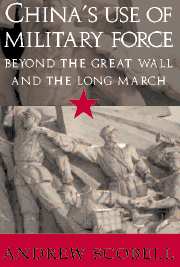Book contents
- Frontmatter
- Contents
- Preface
- China's Use of Military Force
- 1 Introduction
- Part I Layers of Culture
- Part II Use of Force in the Mao Era
- Part III Use of Force in the Deng Era
- 6 Half-Hearted Coercive Diplomacy: China's 1979 Attack on Vietnam
- 7 Why the People's Army Fired on the People: Beijing, 1989
- Part IV Use of Force in the Post-Deng Era
- Notes
- Bibliography
- Index
6 - Half-Hearted Coercive Diplomacy: China's 1979 Attack on Vietnam
Published online by Cambridge University Press: 29 July 2009
- Frontmatter
- Contents
- Preface
- China's Use of Military Force
- 1 Introduction
- Part I Layers of Culture
- Part II Use of Force in the Mao Era
- Part III Use of Force in the Deng Era
- 6 Half-Hearted Coercive Diplomacy: China's 1979 Attack on Vietnam
- 7 Why the People's Army Fired on the People: Beijing, 1989
- Part IV Use of Force in the Post-Deng Era
- Notes
- Bibliography
- Index
Summary
THE ferocious artillery barrage and subsequent massed infantry assault on Vietnam by the Chinese People's Liberation Army (PLA) on February 17, 1979, should not have come as a complete surprise to anyone. While the precise timing of the attack might have been unexpected, the military assault itself had been anticipated for months. After a month of fighting, China unilaterally announced it would withdraw and the PLA pulled back across the border into China, leaving scenes of total devastation behind it. The Vietnamese proved themselves tough adversaries, and the PLA performed worse than Beijing had anticipated.
Why did Beijing initiate the war? What did Chinese leaders hope to accomplish from the conflict? This, the largest military operation conducted outside China's borders since the Korean War, has been carefully studied by a handful of scholars, with the primary focus being its international causes and consequences. Monographs have studied China's foreign policy goals, emphasizing that Beijing's decision was triggered by the strengthening of ties between Vietnam and the Soviet Union – China's major adversary at the time. In addition, Vietnam allegedly committed numerous incursions into Chinese territory and adopted a policy of forcing hundreds of thousands of ethnic Chinese residents to flee Vietnam. The final straw was Vietnam's all-out invasion of Cambodia – officially the Democratic Republic of Kampuchea – launched on December 25, 1978. However, little attention has been given to the domestic political dimensions of the conflict.
- Type
- Chapter
- Information
- China's Use of Military ForceBeyond the Great Wall and the Long March, pp. 119 - 143Publisher: Cambridge University PressPrint publication year: 2003
- 1
- Cited by

